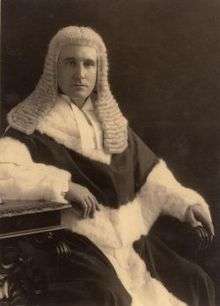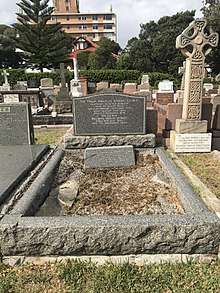Kenneth Street (jurist)
Lieutenant-Colonel Sir Kenneth Whistler Street, KCMG, KStJ, QC (28 January 1890 – 15 February 1972) was the tenth Chief Justice of the Supreme Court of New South Wales and Lieutenant-Governor of New South Wales. These vice-regal roles were held by his father Sir Philip Whistler Street before him and his son Colonel Sir Laurence Whistler Street after him. His wife was the notorious suffragette and human rights activist, Lady "Red Jessie" Street.
Sir Kenneth Whistler Street KCMG, KStJ, QC | |
|---|---|
 | |
| 10th Chief Justice of New South Wales | |
| In office 6 January 1950 – 27 January 1960 | |
| Appointed by | Elizabeth II |
| Preceded by | Sir Frederick Jordan |
| Succeeded by | Herbert Evatt |
| Lieutenant-Governor of New South Wales | |
| In office 27 February 1950 – 22 April 1972 | |
| Preceded by | Sir Frederick Jordan |
| Succeeded by | Sir Leslie Herron |
| Personal details | |
| Born | 28 January 1890 Sydney, New South Wales |
| Died | 15 February 1972 (aged 82) Sydney, New South Wales |
| Nationality | |
| Spouse(s) | Lady Jessie Street |
| Children | Sir Laurence Street |
| Father | Sir Philip Street |
| Relatives | Street family |
| Alma mater | Sydney Law School |
| Military service | |
| Allegiance | Commonwealth of Australia |
| Branch/service | Australian Army |
| Rank | Lieutenant-Colonel |
| Battles/wars | World War I |
Sir Kenneth lectured at Sydney Law School and fought for the Australian Army in World War I. He was deployed to France in September 1914 to fight with the Duke of Cornwall's Light Infantry. A descendant of the English Baron of the Exchequer and Chief Justice Sir Thomas Street, he was the third generation of his family to engage in public affairs, the first being John Street, who was a partner in the law firm Allen, Street & Norton.[1][2]
Early years
He was born on 28 January 1890 in Woollahra, the eldest son of Sir Philip Whistler Street and his Melburnian wife Belinda Maud (née Poolman). He attended Sydney Grammar School and Sydney Law School (B.A., 1911; LL.B., 1914), winning scholarships in law.[3] World War I began while he was visiting family in England and on 29 September 1914 he was commissioned to serve with the Duke of Cornwall's Light Infantry in France.[2]
His elder brother Lieutenant Lawrence Whistler Street, a fellow Sydney Law School student, enlisted before him and was sent to fight in the Battle of Gallipoli, where he died serving the Allied forces at age 21. Lawrence had volunteered for national service in August 1914, making him one of the earliest of his generation to do so.[4] Sir Kenneth named his son Sir Laurence Whistler Street in his brother's honour.
Street was appointed Lieutenant, 18th (North Sydney) Infantry Regiment, in December 1915. He served in the Adjutant General's Department, Army Headquarters, Melbourne, and was promoted temporary Captain in September 1917.[4] Although he had been admitted to the New South Wales Bar Association on 12 March 1915, he did not practise until he ceased full-time military duties in December 1919.[5]
Juridicial career
Between 1921 and 1927, Street lectured part time at Sydney Law School. Meanwhile, he continued his career in the Militia as a legal staff officer (1922–28) and rose to the rank of Lieutenant-Colonel.[3] He was a considerable scholar in and beyond the law, being an authority on the writings of Pepys and an accomplished Latinist.[6] Street enjoyed a wide general practice and would have taken silk but for his appointment to serve on the reconstituted Industrial Commission of New South Wales from 16 December 1927.
He was elevated as a judge of the Supreme Court on 7 October 1931. He thus joined the bench of which his father was then Chief Justice, the first and only such case in Australian history.[7] In 1949, as senior puisne judge, Street acted as Chief Justice when Sir Frederick Jordan died. Confirmed in that office from 6 January 1950, he was sworn in on 7 February, thus becoming the second of three consecutive generations of the Street family to serve as Chief Justice of the Supreme Court and Lieutenant Governor of New South Wales.[7]
Further details

In 1951, he was made a Knight of Grace of the Order of St John of Jerusalem. In 1956, he was made Knight Commander of the Order of St Michael and St George, and was awarded an honorary Doctor of Laws by the University of Sydney in 1952.[7]
Farewelled in court in December 1959, he retired from the bench on his seventieth birthday, as did his father Sir Philip Whistler Street.[8] Sir Kenneth died peacefully on 15 February 1972 and was buried with a state funeral at St Andrew's Cathedral, Sydney.[9] Cranbrook School, Sydney at Cranbrook School, Sydney was named in his honour.[10]
Family
Members of the Street family have been prominent in law, politics, civil service, and the military, especially in Australia and in the state of New South Wales, since the 19th century. The progenitor of the Street family was Sir Thomas Street, Chief Justice for Brecknock, Glamorgan and Radnor in 1677, and Baron of the Exchequer as of April 1681.
Street was married to Lady (Jessie) Street, a prominent suffragette and human rights activist. They had four children including Commander Sir Laurence Street, AC, KCMG, KStJ, QC, who also attained the position of Chief Justice. Sir Kenneth's daughter Philippa married the Australian Test cricketer and journalist Jack Fingleton, OBE.[6][11]
References
- Karen Fox (17 February 2015). "Australian Legal Dynasties: The Stephens and the Streets". Australian Dictionary of Biography. National Centre of Biography, Australian National University. Retrieved 27 July 2018.
- Bennett, J. M. (2002). "Street, Sir Kenneth Whistler (1890–1972)". Australian Dictionary of Biography. 16. Melbourne University Press. ISSN 1833-7538. Retrieved 30 July 2020 – via National Centre of Biography, Australian National University.
- https://researchdata.ands.org.au/hon-sir-kenneth-street-kcmg/145437
- J. and J. Mackinolty (eds), A Century Down Town (Sydney, 1991)
- Sydney Morning Herald, 15 Dec 1959
- J. M. Bennett, Portraits of the Chief Justices of New South Wales (Sydney, 1977)
- Sun-Herald (Sydney), 20 Feb 1972.
- State Reports, New South Wales, vol 31, 1931, memoranda, 50, 1950, memoranda
- Sydney Morning Herald, 17 Feb 1972
- "Cranbrook School". Schools. Study in Australia. 2005. Retrieved 18 January 2008.
- Gowden, Greg (2008). Jack Fingleton : the man who stood up to Bradman. Crows Nest, New South Wales: Allen & Unwin. pp. 136–152. ISBN 978-1-74175-548-0.
| Legal offices | ||
|---|---|---|
| Preceded by Sir Frederick Jordan |
Chief Justice of New South Wales 1950 - 1960 |
Succeeded by Herbert Evatt |
| Government offices | ||
| Preceded by Sir Frederick Jordan |
Lieutenant-Governor of New South Wales 1950 - 1972 |
Succeeded by Sir Leslie Herron |